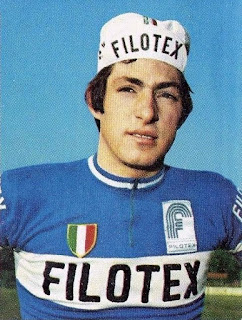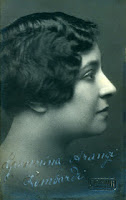Only two riders have won more road races
 |
Francesco Moser was one of the greatest
road racers of his or any era |
The cycling champion Francesco Moser, winner of the 1984 Giro d’Italia and the 1977 World road racing championship among 273 road victories in his career, was born on this day in 1951 in Palù di Giovo, a village about 10km (6 miles) north of Trento in northern Italy.
Only the great Belgians Eddy Merckx (525) and Rik Van Looy (379) won more road races than Moser, who was at his peak during the late 1970s and early 1980s. One of his proudest achievements was to break Merckx’s record for the greatest distance covered in one hour.
He became renowned as a specialist in the so-called Monuments, the five road races among what are generally termed the Classics considered to be the oldest, hardest and most prestigious one-day events in cycling.
Of those events, Moser won the Paris-Roubaix three times, the
Giro di Lombardia twice and the
Milan-San Remo once.
Moser attributed his cycling prowess to growing up on the family farm in
Val di Cembra, working in steep-sided vineyards in an era when most of the work was carried out by hand, rather than machinery. Family members used bicycles to move around the estate, where he worked for four years between leaving school at 14 and beginning to focus on his cycling career at 18.
 |
Moser competed for Italy at the 1972
Olympic Games in Munich |
He continued to help out on the farm for a couple of years after that, and attributes his physical strength to hours of manual labour. In an age when nutritional supplements were not the norm, he felt his Mediterranean diet also gave him an advantage.
Before turning professional, Moser competed in the individual road race and team time trial events at the 1972 Summer Olympics in Munich. He had won the
Girobio - the amateur Giro d'Italia - in 1971.
He was the most gifted and driven of four cycling Moser brothers, the others being Aldo, Enzo and Diego. His achievements clearly encouraged others in the family: a nephew, Moreno Moser, is a professional racer, and Francesco's son
Ignazio Moser enjoyed success at the junior and amateur levels before retiring at the age of 22
Despite his success in the Giro d’Italia, in which he and his great rival
Giuseppe Saronni broke the hold of the Belgians and French on the event, Moser always put the Classics ahead of the Grand Tours, considering his qualities were better suited to one-day races rather than the endurance events.
Of those the Paris-Roubaix was his favourite. After finishing second in 1974 behind Roger De Vlaeminck and in 1976 behind Marc Demeyer of Belgium, Moser finally won the event three consecutive times. Only De Vlaeminck, with nine, had more podium finishes than Moser’s seven podium finishes in Paris–Roubaix; only De Vlaeminck, with nine, has more.
 |
Moser pictured at the Giro d'Italia in
2011, after his retirement |
The 1974 season had been his first as a professional. After he won Paris-Tours, the Tours of Emilia, Tuscany and Piedmont, as well as being second in Paris-Roubaix and seventh in the Giro d'Italia and the World Championships, it was clearly he was going to be a force.
After his two second places, in 1978 he beat De Vlaeminck and Jan Raas of the Netherlands; in 1979, De Vlaeminck and Hennie Kuiper of the Netherlands; and in 1980, Gilbert Duclos-Lassalle of France and the German, Dietrich Thurau.
Moser came in third in 1981 behind Bernard Hinault and Roger De Vlaeminck, and was also third in 1983 behind Hennie Kuiper and Gilbert Duclos-Lassalle. He rode Paris–Roubaix in his final season as a cyclist in 1987.
His other Monument victories came in 1975 and 1978 in the Giro di Lombardia, and in the 1984 Milan–San Remo.
Moser won the 1977 world road racing championship in San Cristobal, Venezuela. He was also the silver medallist in 1976, behind Freddy Maertens of Belgium, and second in 1978 to Gerrie Knetemann of the Netherlands.
Despite his preference, Moser had some success in the three-week grand tours.
He rode the
Tour de France in 1975, and although he won two stages, led the race for seven days and won the young rider competition, he never rode the Tour again, claiming the mountains did not suit him. He was never seen as a good climber.
 |
One of the aerodynamic bikes produced by Moser at his
factory in Trento. He broke the hour record on one similar |
It was against the odds, therefore, that he won the
1984 Giro d'Italia, coming home ahead of Laurent Fignon of France and Moreno Argentin of Italy. On an unusually flat course, Moser used time-trialing ability to overcome the setbacks he suffered in the mountain stages. He also won the points classification in the Giro in 1976, 1977, 1978 and 1982.
He said in an interview in 2015 he said that his team were always focused on the Giro ahead of the Tour de France and it was difficult to ride both in the same year.
Among Moser’s other Classic wins were the 1974 Paris–Tours, the 1977 Züri-Metzgete, the 1979 Gent–Wevelgem, and the 1977 Flèche Wallonne.
It was on January 19, 1984, in Mexico City, that Moser broke the 1972 hour record of Eddy Merckx, at the age of 32.
He rode 50.808km (31.57 miles) on an aerodynamic bike with full disc wheels more advanced than the conventional bike Merckx used in 1972. Later, in 1997, the Union Cycliste Internationale banned hour records set on bikes featuring technological advantages. Under these new rules, Merckx's record stood until 2000.
In retirement, Moser started a bike company,
Moser Cicli, in a workshop in Trento, and was appointed the first chairman of the CPA (Cyclistes Professionels Associés), a union for professional riders. He held the position from 1999 until 2007.
Moser also continued his father's winery with his children Francesca, Carlo and Ignazio on the family estate, Maso Villa Warth, experimenting with new grape varieties. A passionate hunter, he hosted a television series A Caccia con Moser - Hunting with Moser.
 |
The Piazza del Duomo in Trento, the city considered one
of the most attractive places to live in Italy |
Travel tip:
The cosmopolitan city of
Trento is considered to be one of the most desirable places to live in Italy on the basis of job opportunities and quality of life. With a population of 117,000, it is situated in an Alpine valley on the Adige river between the northern tip of Lake Garda and the border city of Bolzano, about 115km (71 miles) north of Verona. Settled by the Romans in the first century, it changed hands many times before becoming a major city in the Holy Roman Empire. The Austrians took charge in the 14th century and it remained under their control, with the exception of a spell of French domination in the Napoleonic era until the First World War. It is notable in the 16th century for hosting the Council of Trent, the ecumenical council of the Catholic Church that gave rise to the resurgence of the church following Protestant Reformation.
 |
The Church of Santa Maria Assunta di Giovo, with its
50m (262yds) tall bell tower |
Travel tip:
The
Church of Santa Maria Assunta in Verla di Giovo, site of the parish church of Giovo, was built in the years 1766 to 1774, designed by the Como architect Caminada, Built in late Baroque style, it has a solemn facade, punctuated by pilasters and stucco cornices . On the southern side rises the bell tower, also eighteenth century, 50m (262 yards) tall and dominated by a characteristic pear-shaped dome. The high altar is the work of Domenico Sartori, as are the statues of San't Antonio Abate and San Sebastiano placed on the same altar.
Also on this day:
1918: The death of flying ace Francesco Baracca
1932: The birth of Hollywood actress Pier Angeli
1932: The birth of Pier Angeli's twin, Marisa Pavan
Home















